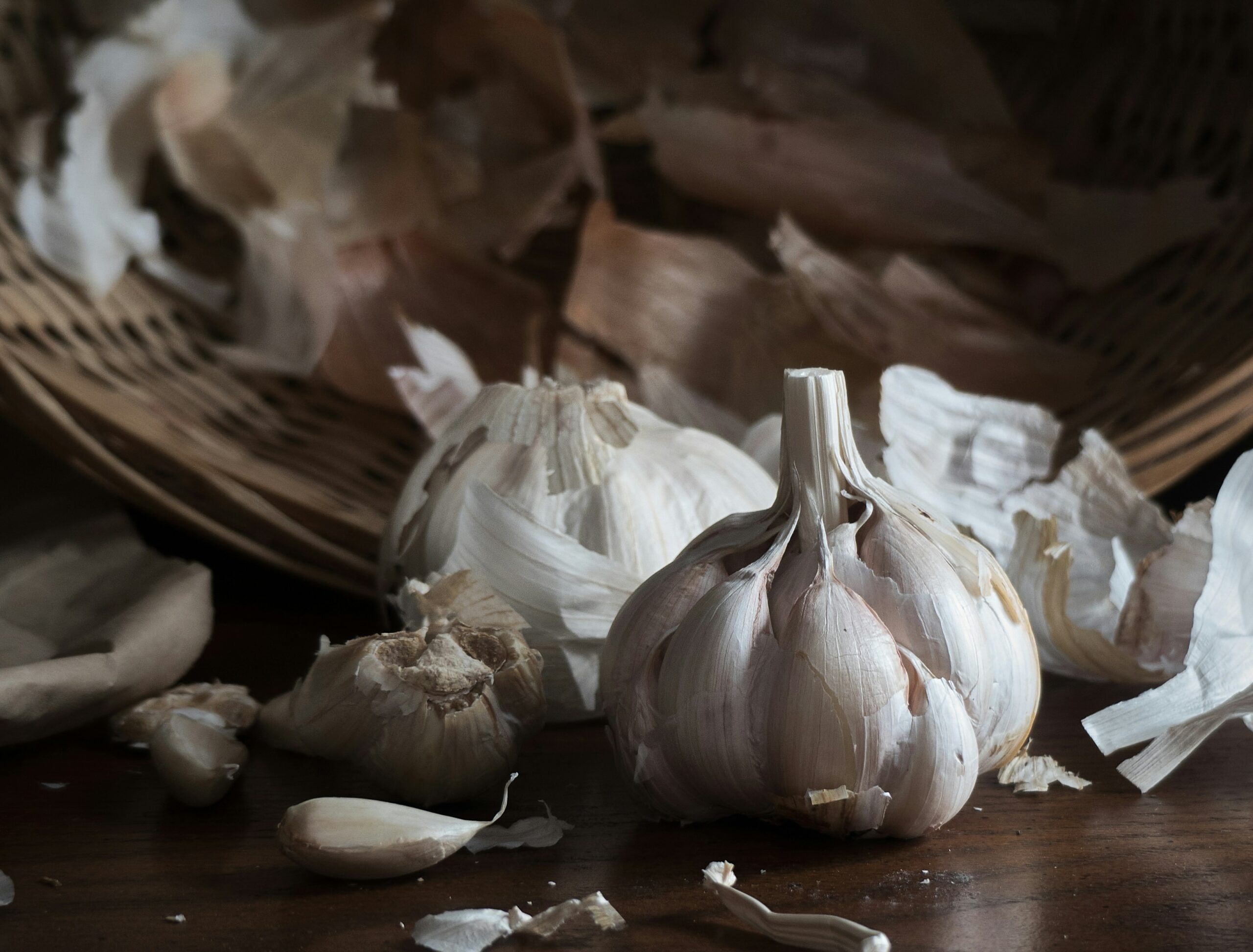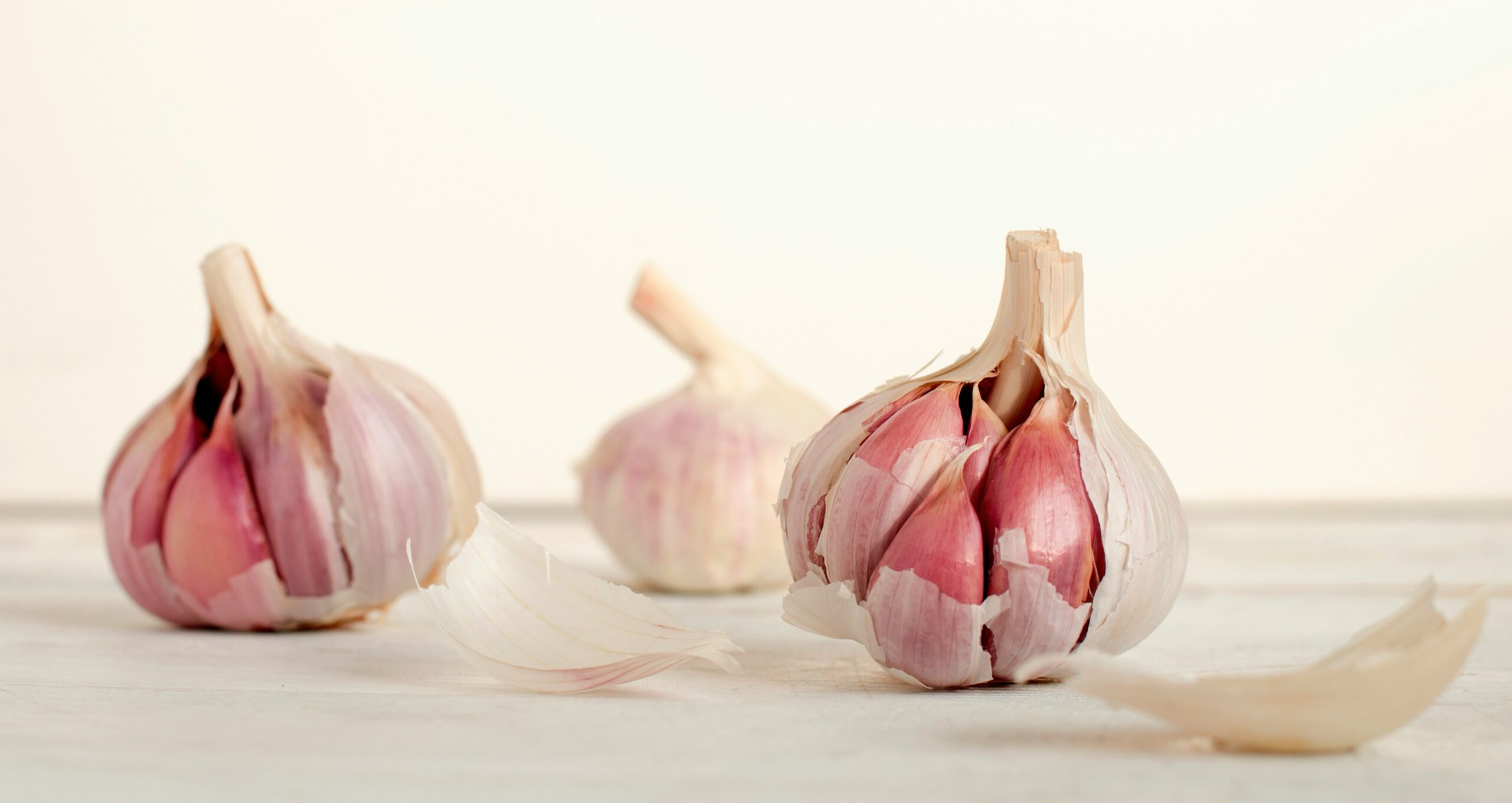Garlic is a plant grown mainly for food purposes. The plant can be used as a vegetable, a spice, or a medicinal herb. The garlic stem develops from the root bulb, which is the most valuable. The garlic bulb consists of cloves, which are buds.
Consuming garlic cloves can have a healthy effect on the human body, which is why the plant is prevalent. The white-cream garlic cloves can be eaten fresh. In this form, parts of the plant have an intense, slightly spicy flavor.
Garlic originated in Central Asia and is now grown all over the world. Due to its nutritional content and bioactive elements, the root bulb has many health benefits and is sometimes used in natural medicine as a healing agent. Garlic can be consumed in various ways and is added to dishes in many different types. However, fresh, non-heat-treated garlic has the highest health content. Various garlic-based products and supplements are also available.
The plant is recommended for many ailments, so it is worth knowing its benefits. However, in some situations, garlic may not be advisable. The plant can also cause side effects, especially when consumed too large.

Garlic (Allium sativum L.![]() ) was used for medicinal purposes thousands of years ago. Historically, the plant helped with many ailments for which no medicines were available in the old days. Today, garlic still maintains its popularity due to its numerous health benefits. The benefits are because the plant has a high concentration of sulfur-containing
) was used for medicinal purposes thousands of years ago. Historically, the plant helped with many ailments for which no medicines were available in the old days. Today, garlic still maintains its popularity due to its numerous health benefits. The benefits are because the plant has a high concentration of sulfur-containing![]() compounds. Many scientific studies carried out confirmed the medicinal properties of root bulbs. Health benefits can, therefore, include:
compounds. Many scientific studies carried out confirmed the medicinal properties of root bulbs. Health benefits can, therefore, include:
Garlic is a plant that can give support to various cardiovascular problems. The vegetable has antihypertensive properties, being able to lower diastolic blood pressure. Therefore, the presence of garlic in the diet can support mild hypertensive conditions. In addition, root bulbs may have a role in treating and preventing thrombosis![]() . Consumption of the plant had the effect of reducing platelet aggregation. A reduction in atherosclerotic plaque volume was also reported in patients. The vegetable and herbal preparations of garlic may block the progression of the disease. Therefore, garlic may reduce patients' risk of atherosclerosis
. Consumption of the plant had the effect of reducing platelet aggregation. A reduction in atherosclerotic plaque volume was also reported in patients. The vegetable and herbal preparations of garlic may block the progression of the disease. Therefore, garlic may reduce patients' risk of atherosclerosis![]() , leading to severe conditions such as myocardial infarction and ischaemic stroke.
, leading to severe conditions such as myocardial infarction and ischaemic stroke.

Many studies have been carried out on garlic, and it has been shown that its consumption can lower total cholesterol levels. Garlic can, therefore, be effective in lowering lipid levels, comparable to some drugs that are used for high cholesterol. Experts also suggest that it may be helpful to combine garlic with coriander![]() , which will increase the lipid-lowering effects. Combining these ingredients can modulate body weight and lower blood pressure.
, which will increase the lipid-lowering effects. Combining these ingredients can modulate body weight and lower blood pressure.
Scientific studies have noted that garlic's active compounds can reduce hyperglycemia. This effect of root bulbs on the human body is significant for people with diabetes![]() . Garlic may improve the antioxidant status in the circulation. The plant present in the diet controls diabetes by influencing glucose parameters. In addition, patients with diabetes and uncontrolled dyslipidemia may gain additional benefits from consuming root bulbs, which also affect the lipid profile.
. Garlic may improve the antioxidant status in the circulation. The plant present in the diet controls diabetes by influencing glucose parameters. In addition, patients with diabetes and uncontrolled dyslipidemia may gain additional benefits from consuming root bulbs, which also affect the lipid profile.
Some studies also indicate that garlic combats harmful microorganisms. The plant can act against viruses, fungi, parasites, and Gram-positive and Gram-negative bacteria. The plant, which has anti-fungal and anti-itch properties, alleviates microbial skin diseases like the wart virus![]() . In natural medicine, the root bulb has been used for various ordinary infections, such as inflammation of the digestive and respiratory systems. Garlic may help treat colds, but more research is needed to confirm its effects in this area.
. In natural medicine, the root bulb has been used for various ordinary infections, such as inflammation of the digestive and respiratory systems. Garlic may help treat colds, but more research is needed to confirm its effects in this area.
Garlic contains many active ingredients that give it antioxidant effects. The plant and products based on it can increase antioxidant activity in the body if garlic is consumed regularly over a long-term period. In patients who provided root bulbs for several months, modulation of oxidative stress markers was noted. It is also essential that the diet is rich in different antioxidants to increase the antioxidant effects of garlic.

Many diseases and conditions can cause inflammation in the body. Garlic's reduction of inflammatory biomarkers may benefit patients struggling with diseases such as end-stage renal failure![]() . The plant contains several active substances that can further strengthen the immune system by increasing immune cell activity and modulating cytokine production. The anti-inflammatory properties and immune system improvement mean that root bulbs can treat and protect the body from infection.
. The plant contains several active substances that can further strengthen the immune system by increasing immune cell activity and modulating cytokine production. The anti-inflammatory properties and immune system improvement mean that root bulbs can treat and protect the body from infection.
Because all cancers are complex diseases to treat, scientists constantly look for new ways to deal with the problem. According to some experts, much attention is paid to diet and foods that can protect or influence the cancer treatment process. Studies have noted a link between garlic consumption and the development of colorectal, kidney, oral, and other types of cancer. In addition, it has been said that vegetables can reduce the symptoms of various cancers. However, the links between this plant and cancer risk reduction are insufficient and uncertain.
Garlic grown all over the world shows its therapeutic effects due to the activity of the many components and compounds it contains. Fresh garlic consists mainly of carbohydrates and has a high amount of protein. The vegetable has very little fat and is a low-calorie product. You will also find fiber in garlic. The macronutrient ratio is very favorable, and in addition to it, the plant also contains micronutrients and bioactive compounds such as:

The main constituents associated with many of garlic's health benefits are sulfur-organic chemical compounds. Many types of such chemical compounds can be found in the plant. Sulfur-containing compounds support the functioning of the body in various ways. One of the most essential sulfur-containing compounds is allicin![]() , which is vital for health. Most bioactive sulfur-containing compounds are found in fresh garlic, preferably after the garlic cloves have been sliced or crushed, as this is when chemical reactions occur to release more of the beneficial compounds. On the other hand, dried garlic preparations must be enteric-coated so that stomach acid does not inhibit the compounds.
, which is vital for health. Most bioactive sulfur-containing compounds are found in fresh garlic, preferably after the garlic cloves have been sliced or crushed, as this is when chemical reactions occur to release more of the beneficial compounds. On the other hand, dried garlic preparations must be enteric-coated so that stomach acid does not inhibit the compounds.
Garlic also contains many steroidal saponins, which are very active blood pressure-lowering compounds. Saponins found in the plant have been linked to various health-promoting effects, enhancing garlic's antioxidant activity and improving immune system function.
Phenolic compounds are also found in the root bulb. Polyphenolic compounds are considered an essential component of the human diet. These substances are renowned for their high antioxidant activity but exhibit several different health-promoting properties. Polyphenols in garlic may be responsible for its beneficial effects on cancer.
Garlic, a vegetable, contains several minerals that contribute to overall human health. The plant has high levels of phosphorus, zinc, and potassium. Selenium, calcium, magnesium, and iron are also found in moderate amounts. Garlic also contains low levels of sodium.
We can also find specific amounts of vitamins in garlic. The plant contains vitamins A and C and all the B vitamins. Providing vitamins in adequate quantities is very important for health, but in addition to garlic, different foods should also be included in the diet.
Root bulbs can be eaten raw, and cloves are safe and edible once peeled from their shells. There are many ways to eat garlic. The vegetable is often used to accompany various dishes, adding an intense flavor. Garlic is also available in powdered form as a spice. The root bulb can also be supplemented with multiple garlic-based tablets and extracts. However, the most healthful version of garlic is the fresh vegetable, which contains the most bioactive ingredients.

A careful dosage of garlic is recommended, as an excess of the ingredient can lead to side effects. In the case of herbal supplements, following the instructions described on the product label is essential. However, for fresh garlic, recommendations include 1-2 cloves![]() of garlic per day for an adult.
of garlic per day for an adult.
Excess garlic in the diet can cause various symptoms, but it is usually harmless side effects. However, it is advisable not to exceed the prescribed doses to avoid unpleasant discomforts. Side effects of garlic include:
Raw garlic has a characteristic, intense odor that can enrich the qualities of a dish. However, vegetables eaten in excess can make patients suffer from bad breath![]() , which can be challenging to get rid of. Large amounts of root bulbs consumed can even result in an unpleasant odor throughout the body. It is related to the numerous sulfated compounds contained in the plant.
, which can be challenging to get rid of. Large amounts of root bulbs consumed can even result in an unpleasant odor throughout the body. It is related to the numerous sulfated compounds contained in the plant.
Raw garlic should not be eaten on an empty stomach, as it can cause unpleasant symptoms. Gastrointestinal symptoms include bloating![]() . The feeling of fullness in the abdominal cavity after eating garlic may persist for some time but usually subsides after digestion. In addition to this, garlic eaten on an empty stomach can cause changes in the intestinal flora, which is detrimental to health. Disruption of the intestinal flora can cause various symptoms, such as vomiting and abdominal pain. In addition, a decrease in immunity, concentration problems, and fatigue are possible due to the change in gut flora.
. The feeling of fullness in the abdominal cavity after eating garlic may persist for some time but usually subsides after digestion. In addition to this, garlic eaten on an empty stomach can cause changes in the intestinal flora, which is detrimental to health. Disruption of the intestinal flora can cause various symptoms, such as vomiting and abdominal pain. In addition, a decrease in immunity, concentration problems, and fatigue are possible due to the change in gut flora.
It has been noted that garlic can cause an allergic skin reaction![]() in some cases. Allergic dermatitis, blisters, and burns have been reported in patients whose skin has come into contact with fresh garlic. Therefore, topical application of garlic can be dangerous, especially for patients with sensitive skin. A food allergy to garlic is diagnosed very rarely but is possible. Respiratory and oral symptoms may occur if an allergic reaction occurs after garlic ingestion.
in some cases. Allergic dermatitis, blisters, and burns have been reported in patients whose skin has come into contact with fresh garlic. Therefore, topical application of garlic can be dangerous, especially for patients with sensitive skin. A food allergy to garlic is diagnosed very rarely but is possible. Respiratory and oral symptoms may occur if an allergic reaction occurs after garlic ingestion.

Garlic is generally considered a safe food. Pregnant women who consume garlic have an impact on the prevention of disease in the newborn and prevent pre-eclampsia. However, consuming foods such as garlic during pregnancy should be consulted with a doctor. Garlic may not be suitable for certain groups, putting patients at risk. Contraindications of the plant include:
Root bulb does not generally affect the metabolism of a drug, but garlic should not be combined with certain substances. It applies, for example, to anticoagulants![]() . Patients using this type of medication should exercise caution by monitoring the presence of garlic in the diet. This is because garlic can excessively increase the anticoagulant effect.
. Patients using this type of medication should exercise caution by monitoring the presence of garlic in the diet. This is because garlic can excessively increase the anticoagulant effect.
People with certain conditions should consume only a few amounts of garlic. It applies to patients with acute gastritis and gastroenteritis. Digestive problems may increase in severity after consuming garlic, which irritates the mucous membranes. Where the illness requires an easy-to-digest diet, garlic is not recommended.
People with low blood pressure should not eat large amounts of garlic. The plant naturally lowers pressure, so too low a pressure level can result in various symptoms. After eating garlic, such patients may experience excessive fatigue, drowsiness, concentration problems, and dizziness.
Patients about to have surgery should take only a few doses of garlic. Eating garlic should be avoided from 7 to 10 days before surgery, as large doses of the vegetable can prolong post-operative bleeding time, increasing the risk of hemorrhage.
Women during menstruation should also not consume large amounts of garlic, as the plant can increase the intensity of bleeding. Garlic can reduce menstrual pain, but it can cause excessive blood loss and weakness when overeating.
Garlic is a popular plant with a distinctive taste and smell. The root bulb of this plant is valued for the numerous health benefits that eating it provides. Garlic affects lipid and glucose levels. It also has many properties that protect the body against various infections and diseases. The beneficial effects of root bulbs are due to their bioactive compounds, such as allicin. However, it is recommended that the vegetable is not eaten in excess, as it can cause side effects. There are also contraindications to eating garlic. When the plant causes problems, it is better to forgo its presence in the diet.